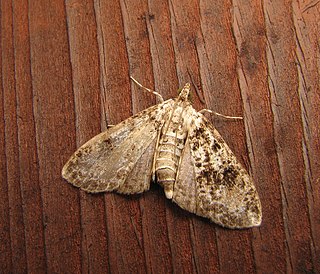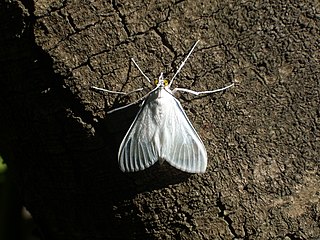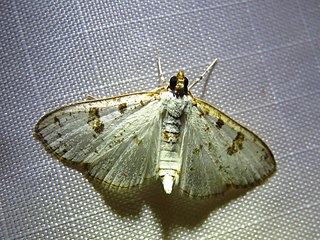
The Pyralidae, commonly called pyralid moths, snout moths or grass moths, are a family of Lepidoptera in the ditrysian superfamily Pyraloidea. In many classifications, the grass moths (Crambidae) are included in the Pyralidae as a subfamily, making the combined group one of the largest families in the Lepidoptera. The latest review by Eugene G. Munroe and Maria Alma Solis retain the Crambidae as a full family of Pyraloidea.

The Pyraloidea are a moth superfamily containing about 16,000 described species worldwide, and probably at least as many more remain to be described. They are generally fairly small moths, and as such, they have been traditionally associated with the paraphyletic Microlepidoptera.

Palpita vitrealis, common name jasmine moth or white pearl, is a species of moth of the family Crambidae.
Paracorsia is a monotypic moth genus of the family Crambidae described by H. Marion in 1959. It contains only one species, Paracorsia repandalis, described by Michael Denis and Ignaz Schiffermüller in 1775. It is found in most of Europe, except Ireland, Fennoscandia and the Baltic region. It has also been recorded from central Asia, including Iran and Kyrgyzstan and North America where it has been recorded in southern Ontario and northern Indiana.

Palpita magniferalis, the splendid palpita snout moth, ash pyralid or ash leafroller, is a moth of the family Crambidae. It is found in eastern North America.

Palpita nigropunctalis, the lilac pyralid, is a moth of the family Crambidae. It is found in eastern Asia, including China, Taiwan, Korea, Japan and the Russian Far East.
Phycita poteriella is a species of snout moth. It is found in North Macedonia, Greece, Bulgaria, Romania, Croatia, Italy and Spain. It has also been recorded from Israel and Yemen.

Palpita maritima is a moth in the family Crambidae. The species was first described by J. Bolling Sullivan and Maria Alma Solis in 2013. It is found in the United States in Alabama, North Carolina and Florida. The habitat consists of coastal maritime forests.

Palpita gracialis, the gracile palpita moth, is a moth of the family Crambidae. It is found in North America, from California to Texas and Oklahoma.
Palpita margaritacea is a moth in the family Crambidae. It was described by Hiroshi Inoue in 1997. It is found in Australia, where it has been recorded from New South Wales, Queensland and the Australian Capital Territory.
Palpita rhodocosta is a moth in the family Crambidae. It was described by Hiroshi Inoue in 1997. It is found in Papua New Guinea and Australia, where it has been recorded from Queensland.
Palpita kimballi, or Kimball's palpita moth, is a moth in the family Crambidae. It was described by Eugene G. Munroe in 1959. It is found in North America, where it has been recorded from Alabama, Florida, Georgia, Louisiana, North Carolina, Oklahoma, South Carolina, Tennessee and Virginia.
Palpita persimilis, the olive shootworm moth, is a moth in the family Crambidae. It was described by Eugene G. Munroe in 1959. It is found in Santa Catarina, Brazil.

Palpita freemanalis, or Freeman's palpita moth, is a moth in the family Crambidae. It was described by Eugene G. Munroe in 1952. It is found in North America, where it has been recorded from Alabama, Illinois, Indiana, Louisiana, Maryland, Mississippi, North Carolina, Oklahoma, South Carolina, Tennessee and Texas.

Palpita annulata is a moth in the family Crambidae. It was described by Johan Christian Fabricius in 1794. It is found in India, Sri Lanka, Myanmar, China, Taiwan and Queensland, Australia.

Palpita flegia, the satin white moth, is a moth in the family Crambidae. It was described by Pieter Cramer in 1777. It is found in Suriname, Colombia, Brazil, Honduras, Nicaragua, Costa Rica, Panama, Mexico, the Caribbean and the United States, where it has been recorded from Alabama, Florida and Texas.
Palpita hyaloptila is a moth in the family Crambidae. It was described by Turner in 1915. It is found in Australia, where it has been recorded from Queensland.

Palpita illibalis, the inkblot palpita moth, is a moth in the family Crambidae. It was described by Jacob Hübner in 1818. It is found in North America, where it has been recorded from Alabama, Florida, Georgia, Maryland, Mississippi, North Carolina, Ohio, Oklahoma, Pennsylvania, South Carolina, Tennessee, Virginia and West Virginia.
Palpita limbata is a moth in the family Crambidae. It is found on Rennell Island and Guadalcanal, as well as in Australia, where it has been recorded from Queensland and New South Wales.
Palpita metallata is a moth in the family Crambidae. It is found in Cameroon, Mayotte, Democratic Republic of Congo, Ghana, Kenya, Nigeria, Sierra Leone, South Africa, Tanzania and Uganda.











